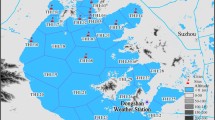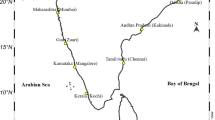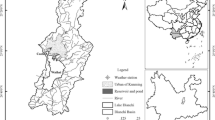Abstract
Meteorological features influence the dynamics of aquatic ecosystems and consequently their biotas. This study aimed to identify the meteorological drivers of phytoplankton biomass (chlorophyll a), sampled seasonally over a period of 12 years (2001–2013) in Lake Mangueira, a large shallow subtropical lake in southern Brazil. The lake is 90 km long and 3–10 km wide with a mean depth of 3 m and is oligo-mesotrophic and highly affected by wind action. In general, non-parametric multiplicative regression analysis identified wind direction, radiation, and the Oceanic Niño Index as the main drivers of variation in chlorophyll a. Notably, ENSO periods caused changes in physical, chemical, and meteorological parameters, including conductivity, total suspended solids, total and dissolved nitrogen, alkalinity, soluble reactive silica, wind speed, and precipitation. Phytoplankton biomass showed significant differences between ENSO periods and the periods without events, occurring in the highest values during La Niña years. This study showed that meteorological variables can significantly influence productivity patterns, indicating the importance of including them in limnological studies.




Similar content being viewed by others
References
Abreu, P. C., Bergesch, M., Proença, L. A., Garcia, C. A. E., & Odebrecht, C. (2010). Short- and long-term chlorophyll a variability in the shallow microtidal Patos Lagoon Estuary, Southern Brazil. Estuaries and Coasts, 33, 554–569. https://doi.org/10.1007/s12237-009-9181-9
Adrian, R., Deneke, R., Mischke, U., Stellmacher, R., & Lederer, P. (1995). A long-term study of the Heiligensee (1975–1992). Evidence for effects of climatic change on the dynamics of eutrophied lake ecosystems. Archiv Für Hydrobiologie, 133(3), 315–337. https://doi.org/10.1127/archiv-hydrobiol/133/1995/315
Adrian, R., Reilly, C. M. O., Zagarese, H., Baines, S. B., Dag, O., Keller, W., et al. (2009). Lakes as sentinels of climate change. Limnology and Oceanography, 54(6), 2283–2297.
Allen, R. G., Pereira, L. S., Raes, D., & Smith, M. (1998). Crop Evapotranspiration-Guidelines for Computing Crop Water Requirements-FAO Irrigation and Drainage Paper 56. FAO, Rome, 300(9), D05109
APHA. (2005). Standard Methods for the Examination of Water and Wastewater. 21st Edition, American Public Health Association/American Water Works Association/Water Environment Federation, Washington DC.
Bartosiewicz, M., Laurion, I., & Maranger, R. (2016). Heat-wave effects on oxygen, nutrients, and phytoplankton can alter global warming potential of gases emitted from a small shallow lake. Enviromental Science & Technology, 50, 6267–6275. https://doi.org/10.1021/acs.est.5b06312
Bohnenberger, J. E., Rodrigues, L. R., Motta-Marques, D., & Crossetti, L. O. (2017). Environmental dissimilarity over time in a large subtropical shallow lake is differently represented by phytoplankton functional approaches. Marine and Freshwater Research, 69(1), 95–104. https://doi.org/10.1071/MF16417
Borges, P. de A., Franke, J., do Santos Silva, F. D., Weiss, H., & Bernhofer, C. (2014). Differences between two climatological periods (2001–2010 vs. 1971–2000) and trend analysis of temperature and precipitation in Central Brazil. Theoretical and Applied Climatology, 116(1–2), 191–202. https://doi.org/10.1007/s00704-013-0947-4
Cardoso, L. F. N., Silva, W. L., & Justi, M. G. A. (2016). Long-term trends in near-surface wind speed over the southern hemisphere : A preliminary analysis. International Journal of Geosciences, 2016(7), 938–943.
Cardoso, L. S., Faria, D. M., Crossetti, L. O., & Motta-Marques, D. (2019). Phytoplankton, periphyton, and zooplankton patterns in the pelagic and littoral regions of a large subtropical shallow lake. Hydrobiologia, 831, 119–132. https://doi.org/10.1007/s10750-018-3729-2
Cardoso, L. S., Fragoso, C. R., Souza, R., & Motta-Marques, D. (2012). Hydrodynamic control of plankton spatial and temporal heterogeneity in subtropical shallow lakes. In H. Schulz, A. Simões, & R. Lobosco (Eds.), Hydrodynamics - Natural Water Bodies (pp. 27–48). Rijeka, Croatia: InTech. https://doi.org/10.5772/711
Cardoso, L. S., & Motta-Marques, D. (2003). Rate of change of the phytoplankton community in Itapeva Lake (North Coast of Rio Grande do Sul, Brazil), based on the wind driven hydrodynamic regime. Hydrobiologia, 497, 1–12. https://doi.org/10.1023/A:1025449202083
Carrick, H. J., Aldridge, F. J., & Schelske, C. L. (1993). Wind induces phytoplankton biomass and composition in a shallow, productive lake. Limnology and Oceanography, 38(6), 1179–1192.
Chen, N., Mo, Q., Kuo, Y., Su, Y., & Zhong, Y. (2018). Hydrochemical controls on reservoir nutrient and phytoplankton dynamics under storms. Science of the Total Environment, 619–620, 301–310. https://doi.org/10.1016/j.scitotenv.2017.09.216
Crossetti, L., Cardoso, L. S., Callegaro, V. L. M., Alves-Da-Silva, S. M., Werner, V. R., Rosa, Z. M., & Da Motta Marques, D. (2007). Influence of the hydrological changes on the phytoplankton structure and dynamics in a subtropical wetland-lake system. Acta Limnologica Brasiliensia, 19(3), 315–329.
Crossetti, L. O., Becker, V., Cardoso, L. S., Rodrigues, L. R., Costa, L. S., & Motta-Marques, D. (2013). Is phytoplankton functional classification a suitable tool to investigate spatial heterogeneity in a subtropical shallow lake? Limnologica, 43(3), 157−163. https://doi.org/10.1016/j.limno.2012.08.010
Crossetti, L. O., Bicudo, D. D. C., Bini, L. M., Dala-Corte, R. B., Ferragut, C., & Bicudo, C. E. D. M. (2018). Phytoplankton species interactions and invasion by Ceratium furcoides are influenced by extreme drought and water-hyacinth removal in a shallow tropical reservoir. Hydrobiologia. https://doi.org/10.1007/s10750-018-3607-y
Crossetti, L. O., Schneck, F., Freitas-Teixeira, L. M., & da Motta-Marques, D. (2014). The influence of environmental variables on spatial and temporal phytoplankton dissimilarity in a large shallow subtropical lake (Lake Mangueira, southern Brazil). Acta Limnologica Brasiliensia, 26(2), 111–118. https://doi.org/10.1590/S2179-975X2014000200002
Fragoso, C. R., Motta Marques, D. M. L., Ferreira, T. F., Janse, J. H., & van Nes, E. H. (2011). Potential effects of climate change and eutrophication on a large subtropical shallow lake. Environmental Modelling & Software, 26(11), 1337–1348. https://doi.org/10.1016/j.envsoft.2011.05.004
Freitas-Teixeira, L. M., Bohnenberger, J. E., Rodrigues, L. R., Schulz, U. H., Motta-Marques, D., & Crossetti, L. O. (2016). Temporal variability determines phytoplankton structure over spatial organization in a large shallow heterogeneous subtropical lake. Inland Waters, 6(3), 325–335. https://doi.org/10.5268/IW-6.3.952
Fuentes, E. V., & Petrucio, M. M. (2015). Water level decrease and increased water stability promotes phytoplankton growth in a mesotrophic subtropical lake. Marine and Freshwater Research, 66(8), 711–718. https://doi.org/10.1071/MF14110
Gocic, M., & Trajkovic, S. (2013). Analysis of changes in meteorological variables using Mann-Kendall and Sen’s slope estimator statistical tests in Serbia. Global and Planetary Change, 100, 172–182. https://doi.org/10.1016/j.gloplacha.2012.10.014
Gómez, F., & Souissi, S. (2008). The impact of the 2003 summer heat wave and the 2005 late cold wave on the phytoplankton in the north-eastern English Channel. Comptes Rendus Biologies, 331, 678–685. https://doi.org/10.1016/j.crvi.2008.06.005
Gran, G. (1952). Determination of the equivalence point in potentiometric titrations. Part 11*. The Analyst, 77, 661–671.
Grimm, A. M., Ferraz, S. E. T., & Gomes, J. (1998). Precipitation anomalies in Southern Brazil associated with El Niño and La Niña events. Journal of Climate, 11(11), 2863–2880. https://doi.org/10.1175/1520-0442(1998)011%3c2863:PAISBA%3e2.0.CO;2
Gsell, A. S., Özkundakci, D., Hébert, M., & Adrian, R. (2016). Quantifying change in pelagic plankton network stability and topology based on empirical long-term data. Ecological Indicators, 65, 76–88. https://doi.org/10.1016/j.ecolind.2015.11.014
Harris, G. P., & Baxter, G. (1996). Interannual variability in phytoplankton biomass and species composition in a subtropical reservoir. Freshwater Biology, 35, 545–560. https://doi.org/10.1111/j.1365-2427.1996.tb01768.x
Havens, K. E., Ji, G., Beaver, J. R., Fulton, R. S., III., & Teacher, C. E. (2019). Dynamics of cyanobacteria blooms are linked to the hydrology of shallow Florida lakes and provide insight into possible impacts of climate change. Hydrobiologia, 829, 43–59. https://doi.org/10.1007/s10750-017-3425-
Havens, K., Paerl, H., Phlips, E., Zhu, M., Beaver, J., & Srifa, A. (2016). Extreme weather events and climate variability provide a lens to how shallow lakes may respond to climate change. Water, 8(229), 1–18. https://doi.org/10.3390/w8060229
Haylock, M. R., Peterson, T. C., Alves, L. M., Ambrizzi, T., Anunciação, Y. M. T., Baez, J., et al. (2006). Trends in total and extreme South American rainfall in 1960–2000 and links with. Journal of Climate, 19, 1490–1513. https://doi.org/10.1175/JCLI3695.1
Hennemann, M. C., & Petrucio, M. M. (2010). Seasonal phytoplankton response to increased temperature and phosphorus inputs in a freshwater coastal lagoon, Southern Brazil: A microcosm bioassay. Acta Limnologica Brasiliensia, 22(3), 295–305. https://doi.org/10.4322/actalb.02203006
Ibelings, B. W., & Maberly, S. C. (1998). Photoinhibition and the availability of inorganic carbon restrict photossynthesis by surface blooms of cyanobacteria. Limnology and Oceanography, 43(3), 408–419.
IPCC. (2014). Climate Change 2014: Synthesis Report.
Jeppesen, E., Meerhoff, M., Davidson, T. A., Trolle, D., Søndergaard, M., Lauridsen, T. L., et al. (2014). Climate change impacts on lakes: An integrated ecological perspective based on a multi-faceted approach, with special focus on shallow lakes. Journal of Limnology, 73(1 SUPPL), 88–111. https://doi.org/10.4081/jlimnol.2014.844
Jespersen, A. M., & Christoffersen, K. (1987). Measurements of chlorophyll―a from phytoplankton using ethanol as extraction solvent. Archiv Für Hydrobiologie, 109(3), 445–454.
Kohler, M., Metzger, J., & Kalthoff, N. (2017). Trends in temperature and wind speed from 40years of observations at a 200-m high meteorological tower in Southwest Germany. International Journal of Climatology. https://doi.org/10.1002/joc.5157
Kottek, M., Grieser, J., Beck, C., Rudolf, B., & Rubel, F. (2006). World Map of the Köppen-Geiger climate classification updated. Meteorologische Zeitschrift, 15(3), 259–263. https://doi.org/10.1127/0941-2948/2006/0130
Lenters, J. D., Kratz, T. K., & Bowser, C. J. (2005). Effects of climate variability on lake evaporation: Results from a long-term energy budget study of Sparkling Lake, northern Wisconsin (USA). Journal of Hydrology, 308(1–4), 168–195. https://doi.org/10.1016/j.jhydrol.2004.10.028
Maberly, S. C., & Elliott, J. A. (2012). Insights from long-term studies in the Windermere catchment: External stressors, internal interactions and the structure and function of lake ecosystems. Freshwater Biology, 57, 233–243. https://doi.org/10.1111/j.1365-2427.2011.02718.x
MacKereth, F. J. H., Heron, J., & Talling, J. F. (1979). Water analysis: some revised methods for limnologist, The Quarterly Review of Biology Washington: Freshwater Biological, 54(2), 203.
Marengo, J. A., & Camargo, C. C. (2008). Surface air temperature trends in Southern Brazil for1960–2002. International Journal of Climatology, 28, 893–904. https://doi.org/10.1002/joc.1584
Marwood, C. A., Smith, R. E. H., Furgal, J. A., Charlton, M. N., Solomon, K. R., & Greenberg, B. M. (2000). Photoinhibition of natural phytoplankton assemblages in Lake Erie exposed to solar ultraviolet radiation. Canadian Journal of Fisheries and Aquatic Sciences, 57(2), 371–379. https://doi.org/10.1139/cjfas-57-2-371
McCune, B. (2006). Nonparametric Multiplicative Regression for Habitat Modeling, Oregon State University, Oregon.
Mccune, B., Berryman, S. D., Cissel, J. H., & Gitelman, A. I. (2003). Use of a Smoother to Forecast Occurrence of Epiphytic Lichens under Alternative Forest Management Plans. Ecological Applications, 13(4), 1110–1123.
McCune, B., & Mefford, M. J. (2011). PC-ORD. Multivariate analysis of ecological data. Gleneden Beach, Oregon: MjM Software.
Morales, C., & Anabalón, V. (2012). Phytoplankton biomass and microbial abundances during the spring upwelling season in the coastal area off Concepción, central-southern Chile: Variability around a time series satation. Progress in Oceanography, 92–95, 81–91.
Odebrecht, C., Abreu, P. C., Möller, O. O., Niencheski, L. F., Proença, L. A., & Torgan, L. C. (2005). Drought effects on pelagic properties in the shallow and turbid Patos Lagoon, Brazil. Estuaries, 28(5), 675–685. https://doi.org/10.1007/BF02732906
Pálffy, K., & Vöros, L. (2003). Effect of ultraviolet radiation on phytoplankton primary production in Lake Balaton. Hydro, 506–509, 289–295.
Panosso, R. F., Attayde, J. L., & Muehe, D. (1998). Morfometria das lagoas Imboassica, Cabiúnas, Comprida e Carapebus: Implicações para seu funcionamento e manejo. In Esteves, F. A. (ed.), Ecologia das Lagoas Costeiras do Parque Nacional da Restinga de Jurubatiba e do Município de Macaé (RJ). NUPEM/UFRJ. Rio de Janeiro. 464 pp. Cap 3.1: pp. 91–108.
Pes, M. P., Pereira, E. B., Marengo, J. A., Martins, F. R., Heinemann, D., & Schmidt, M. (2017). Climate trends on the extreme winds in Brazil. Renewable Energy, 109, 110–120. https://doi.org/10.1016/j.renene.2016.12.101
Plisnier P. D. (2000). Recent climate and limnology changes in Lake Tanganyika, Verh. Internat. Verhandlungen des Internationalen Verein Limnologie, 27: 2670-2673.
Qin, B. (2008). Lake Taihu, China. Springer.
Rao, V. B., & Hada, K. (1990). Characteristics of rainfall over Brazil: Annual variations and connections with the southern oscillation. Theoretical and Applied Climatology, 42, 81–91.
Reichwaldt, E. S., & Ghadouani, A. (2012). Effects of rainfall patterns on toxic cyanobacterial blooms in a changing climate: Between simplistic scenarios and complex dynamics. Water Research, 46(5), 1372–1393. https://doi.org/10.1016/j.watres.2011.11.052
Reynolds, C. S. (2006). The ecology of phytoplankton. Cambridge University Press.
Ribeiro, G. F., Andrade, R. R., Maizonave, C. R. M., & Crossetti, L. O. (2012). Effects of cyanobacterial summer bloom on the phytoplankton structure in an urban shallow lake, Guaíba Lake, southern Brazil. Neotropical Biology and Conservation, 7(2), 78–87. https://doi.org/10.4013/nbc.2012.72.01
Robertson, D. M., Rose, W. J., Reneau, P. C., & Smith, R. (2016). Interannual and long-term changes in the trophic state of a multibasin lake: Effects of morphology, climate, winter aeration, and beaver activity. Canadian Journal of Fisheries and Aquatic Sciences, 73(3), 445. https://doi.org/10.1139/cjfas-2015-0249
Rodrigues, L. R., Fontoura, N. F., & Motta-Marques, D. (2014). Food-web structure in a subtropical coastal lake: How phylogenetic constraints may affect species linkages. Marine and Freshwater Research, 65, 453–465. https://doi.org/10.1071/MF12259
Rodrigues, L. R., Marques, M., & Fontoura, N. F. (2015). Fish community in a large coastal subtropical lake : How an environmental gradient may affect the structure of trophic guilds. Limnetica, 34, 495–506.
Romarheim, A. T., Tominaga, K., Riise, G., & Andersen, T. (2015). The importance of year-to-year variation in meteorological and runoff forcing for water quality of a temperate, dimictic lake. Hydrology and Earth System Sciences, 19(6), 2649–2662. https://doi.org/10.5194/hess-19-2649-2015
Rozema, J., Björn, L. O., Bornman, J. F., Gaberscik, A., Häder, D., Trost, T., et al. (2002). The role of UV-B radiation in aquatic and terrestrial ecosystems — an experimental and functional analysis of the evolution of UV-absorbing compounds. Journal of Photochemistry and Photobiology, 66, 2–12.
Sayemuzzaman, M., & Jha, M. K. (2014). Seasonal and annual precipitation time series trend analysis in North Carolina, United States. Atmospheric Research, 137, 183–194. https://doi.org/10.1016/j.atmosres.2013.10.012
Sobrino, C., Neale, P. J., Phillipskress, J. D., Moeller, R. E., Porter, J. A., Williamson, C. E., Saros, J. E. G., Vincent, W. F., & Smol, J. P. (2009). Elevated CO2 increases sensitivity to ultraviolet radiation in lacustrine phytoplankton assemblages. Limnology and Oceanography, 54, 2448–2459.
Straile, D. (2002). North Atlantic Oscillation synchronizes food-web interactions in central European lakes. Proceedings of the Royal Society b: Biological Sciences, 269(1489), 391–395. https://doi.org/10.1098/rspb.2001.1907
Subash, N., & Sikka, A. K. (2014). Trend analysis of rainfall and temperature and its relationship over India. Theoretical and Applied Climatology, 117, 449–462. https://doi.org/10.1007/s00704-013-1015-9
Teixeira, M. D. S., & Satyamurty, P. (2011). Trends in the frequency of intense precipitation events in southern and southeastern Brazil during 1960–2004. Journal of Climate, 24(7), 1913–1921. https://doi.org/10.1175/2011JCLI3511.1
Thompson, P. A., Bonham, P., Thomson, P., Rochester, W., Doblin, M. A., Waite, A. M., et al. (2014). Climate variability drives plankton community composition changes: The 2010–2011 El Niño to la Niña transition around Australia. Journal of Plankton Research, 37(5), 966–984. https://doi.org/10.1093/plankt/fbv069
Trenberth, K. E. (1997). The definition of El Niño. Bulletin of the American Meteorological Society, 78, 2771–2777.
Tuvikene, L., Nõges, T., & Nõges, P. (2011). Why do phytoplankton species composition and “traditional” water quality parameters indicate different ecological status pf a large shallow lake? Hydrobiologia, 660, 3–15.
Vassiliev, I. R., Prasil, O., Wyman, K. D., Kolber, Z., Hanson, A. K., Prentice, J. E., & Falkowski, P. G. (1994). Inhibition of PS H photochemistry by PAR and UV radiation in natural phytoplankton communities *. Photosynthesis Research, 42, 51–64.
Villafañe, V. E., Gao, K., Li, P., Li, G., & Walter Helbling, E. (2007). Vertical mixing within the epilimnion modulates UVR-induced photoinhibition in tropical freshwater phytoplankton from southern China. Freshwater Biology, 52(7), 1260–1270. https://doi.org/10.1111/j.1365-2427.2007.01762.x
Vogt, R. J., Sharma, S., & Leavitt, P. R. (2015). Decadal regulation of phytoplankton abundance and water clarity in a large continental reservoir by climatic, hydrologic and trophic processes. Journal of Great Lakes Research, 41, 81–90. https://doi.org/10.1016/j.jglr.2014.11.007
Wieliczko, A. R., Rodrigues, L. R., Motta-Marques, D., & Crossetti, L. O. (2020). Phytoplankton structure is more influenced by nutrient enrichment than by temperature increase: an experimental approach upon the global changes in a shallow subtropical lake. Limnetica, 39(1), 405–418. https://doi.org/10.23818/limn.39.26
Zepp, R. G., Erickson, D. J., III., Paul, N. D., & Sulzberger, B. (2007). Interactive effects of solar UV radiation and climate change on biogeochemical cycling. Photochemical & Photobiological Sciences, 6(3), 286. https://doi.org/10.1039/b700021a
Zhang, M., Kong, Æ. F., & Wu, Æ. X. (2008). Different photochemical responses of phytoplankters from the large shallow Taihu Lake of subtropical China in relation to light and mixing. Hydrobiologia, 603, 267–278. https://doi.org/10.1007/s10750-008-9277-4
Zhang, Y., van Dijk, M. A., Liu, M., Zhu, G., & Qin, B. (2009). The contribution of phytoplankton degradation to chromophoric dissolved organic matter (CDOM) in eutrophic shallow lakes: Field and experimental evidence. Water Research, 43(18), 4685–4697. https://doi.org/10.1016/j.watres.2009.07.024
Zhou, J., & Lau, K. M. (2001). Principal modes of interannual and decadal variability of summer rainfall over South America. International Journal of Climatology, 21(13), 1623–1644. https://doi.org/10.1002/joc.700
Zhou, Q., Zhang, Y., Lin, D., Shan, K., Luo, Y., Zhao, L., et al. (2016). The relationships of meteorological factors and nutrient levels with phytoplankton biomass in a shallow eutrophic lake dominated by cyanobacteria, Lake Dianchi from 1991 to 2013. Environmental Science and Pollution Research, 23(15), 15616–15626. https://doi.org/10.1007/s11356-016-6748-4
Funding
This study was financed in part by the Coordenação de Aperfeiçoamento de Pessoal de Nível Superior—Brasil (CAPES)—Finance Code 001.
Author information
Authors and Affiliations
Corresponding author
Additional information
Publisher's Note
Springer Nature remains neutral with regard to jurisdictional claims in published maps and institutional affiliations.
Supplementary Information
Below is the link to the electronic supplementary material.
Rights and permissions
About this article
Cite this article
da Rosa Wieliczko, A., Crossetti, L.O., Cavalcanti, J.R. et al. Meteorological drivers and ENSO influence on phytoplankton biomass dynamics in a shallow subtropical lake. Environ Monit Assess 193, 536 (2021). https://doi.org/10.1007/s10661-021-09288-4
Received:
Accepted:
Published:
DOI: https://doi.org/10.1007/s10661-021-09288-4




